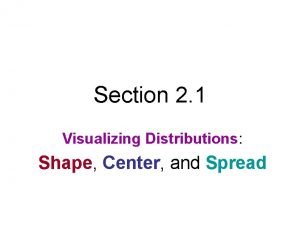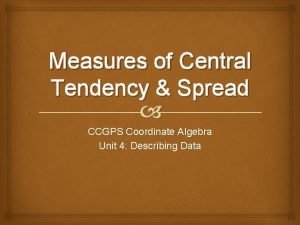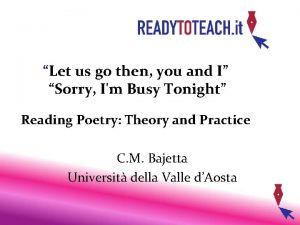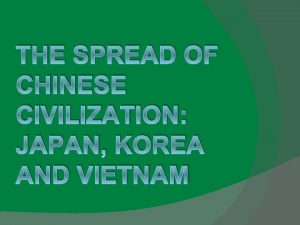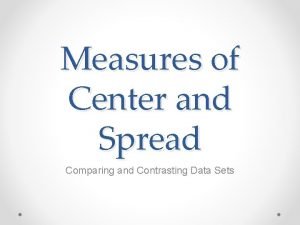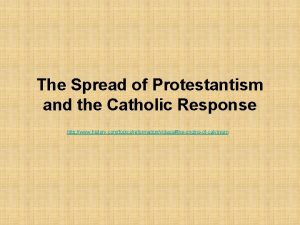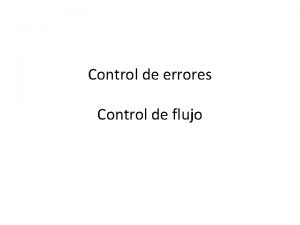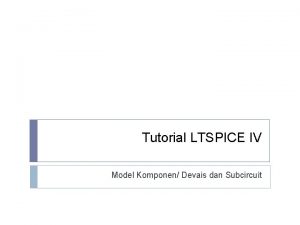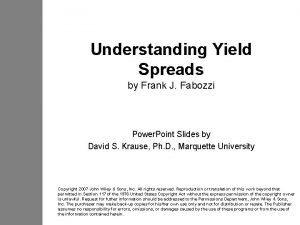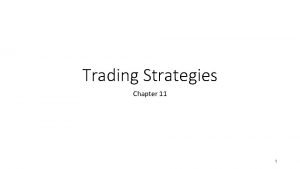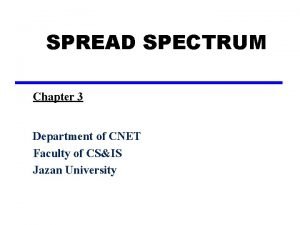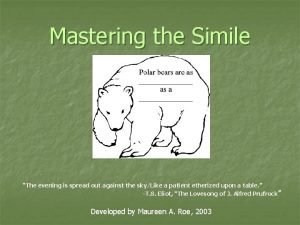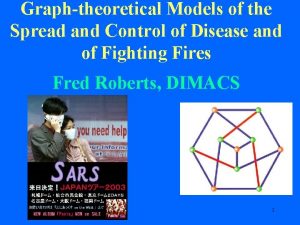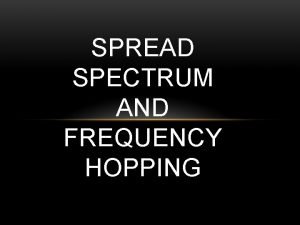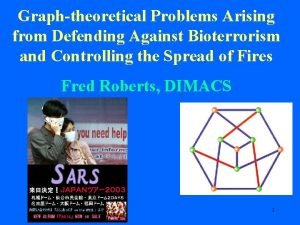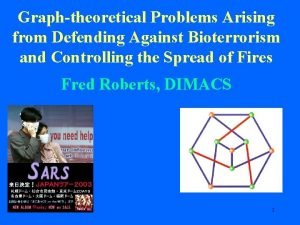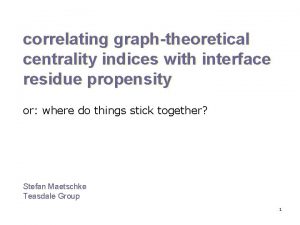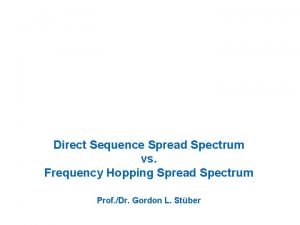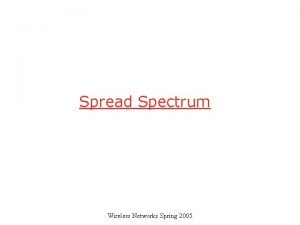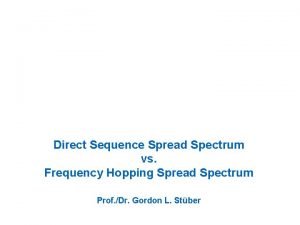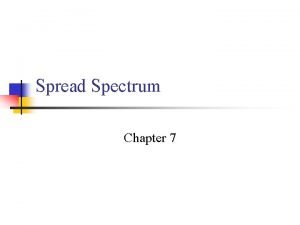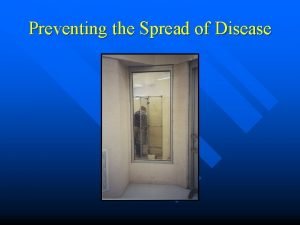Graphtheoretical Models of the Spread and Control of



















































































- Slides: 83

Graph-theoretical Models of the Spread and Control of Disease and of Fighting Fires Fred Roberts, DIMACS 1

2

Understanding infectious systems requires being able to reason about highly complex biological systems, with hundreds of demographic and epidemiological variables. smallpox Intuition alone is insufficient to fully understand 3 the dynamics of such systems.

Experimentation or field trials are often prohibitively expensive or unethical and do not always lead to fundamental understanding. Therefore, mathematical modeling becomes an important experimental and analytical tool. 4

Mathematical models have become important tools in analyzing the spread and control of infectious diseases, especially when combined with powerful, modern computer methods for analyzing and/or simulating the models. 5

What Can Math Models Do For Us? 6

What Can Math Models Do For Us? • Sharpen our understanding of fundamental processes • Compare alternative policies and interventions • Help make decisions. • Prepare responses to bioterrorist attacks. • Provide a guide for training exercises and scenario development. • Guide risk assessment. • Predict future trends. 7

Mathematical Models of Disease Spread Math. models of infectious diseases go back to Daniel Bernoulli’s mathematical analysis of smallpox in 1760. 8

Hundreds of math. models since have: • highlighted concepts like core population in STD’s; 9

• Made explicit concepts such as herd immunity for vaccination policies; 10

• Led to insights about drug resistance, rate of spread of infection, epidemic trends, effects of different kinds of treatments. 11

Great concern about the deliberate introduction of diseases by bioterrorists has led to new challenges for mathematical modelers. smallpox 12

ASIDE: TOPOFF 3 • Bioterrorism exercise in NJ, CT. , Canada in April 2005. • Pneumonic plague released by terrorists. • University observers. pneumonic plague in India • Meeting this afternoon with representatives of Dept. of Health, State Police, etc. Later with Dept. of Homeland Security. 13

The size and overwhelming complexity of modern epidemiological problems -- and in particular the defense against bioterrorism -- calls for new approaches and tools. 14

Models of the Spread and Control of Disease through Social Networks • Diseases are spread through social networks. • “Contact tracing” is an important part of any strategy to combat outbreaks of infectious diseases, whether naturally occurring or resulting from 15 bioterrorist attacks.

The Model: Moving From State to State Social Network = Graph Vertices = People Edges = contact Let si(t) give the state of vertex i at time t. AIDS Simplified Model: Two states: 0 and 1: 0 = susceptible, 1 = infected (SI Model) Times are discrete: t = 0, 1, 2, … 16

The Model: Moving From State to State More complex models: SI, SEIR, etc. measles S = susceptible, E = exposed, I = infected, R = recovered (or removed) SARS 17

First Try: Majority Processes Basic Irreversible Majority Process: You change your state from 0 to 1 at time t+1 if a majority of your neighbors are in state 1 at time t. You never leave state 1. (No change in case of “ties”) Note influence of elections. Useful in models of spread of opinion. Disease interpretation? Infected if more than half of your neighbors are infected. Does this make 18 sense?

Second Try: Threshold Processes Irreversible k-Threshold Process: You change your state from 0 to 1 at time t+1 if at least k of your neighbors have state 1 at time t. You never leave state 1. Disease interpretation? Infected if sufficiently many of your neighbors are infected. Special Case k = 1: Infected if any of your neighbors is infected. 19

Irreversible 2 -Threshold Process 20

21

22

Vaccination Strategies Mathematical models are very helpful in comparing alternative vaccination strategies. The problem is especially interesting if we think of protecting against deliberate infection by a 23 bioterrorist.

Vaccination Strategies If you didn’t know whom a bioterrorist might infect, what people would you vaccinate to be sure that a disease doesn’t spread very much? (Vaccinated vertices stay at state 0 regardless of the state of their neighbors. ) Try odd cycles. Consider an irreversible 2 threshold process. Suppose your adversary has enough supply to infect two individuals. Smallpox vaccinations, NYC 1947 24

Vaccination Strategies Strategy 1: “Mass vaccination”: make everyone 0 and immune in initial state. In 5 -cycle C 5, mass vaccination means vaccinate 5 vertices. This obviously works. In practice, vaccination is only effective with a certain probability, so results could be different. Can we do better than mass vaccination? What does better mean? If vaccine has no cost and is unlimited and has no side effects, of course we use mass vaccination. 25

Vaccination Strategies What if vaccine is in limited supply? Suppose we only have enough vaccine to vaccinate 2 vertices. Consider two different vaccination strategies: Vaccination Strategy II 26

Vaccination Strategy I: Worst Case (Adversary Infects Two) Two Strategies for Adversary Strategy Ia Adversary Strategy Ib 27

The “alternation” between your choice of a defensive strategy and your adversary’s choice of an offensive strategy suggests we consider the problem from the point of view of game theory. The Food and Drug Administration is studying the use of game-theoretic models in the defense against bioterrorism. 28

Vaccination Strategy I Adversary Strategy Ia 29

Vaccination Strategy I Adversary Strategy Ib 30

Vaccination Strategy II: Worst Case (Adversary Infects Two) Two Strategies for Adversary Strategy IIa Adversary Strategy IIb 31

Vaccination Strategy II Adversary Strategy IIa 32

Vaccination Strategy II Adversary Strategy IIb 33

Conclusions about Strategies I and II If you can only vaccinate two individuals: Vaccination Strategy II never leads to more than two infected individuals, while Vaccination Strategy I sometimes leads to three infected individuals (depending upon strategy used by adversary). Thus, Vaccination Strategy II is better. 34

The Saturation Problem Attacker’s Problem: Given a graph, what subsets S of the vertices should we plant a disease with so that ultimately the maximum number of people will get it? Economic interpretation: What set of people do we place a new product with to guarantee “saturation” of the product in the population? Defender’s Problem: Given a graph, what subsets S of the vertices should we vaccinate to guarantee that as few people as possible will be infected? 35

k-Conversion Sets Attacker’s Problem: Can we guarantee that ultimately everyone is infected? Irreversible k-Conversion Set: Subset S of the vertices that can force an irreversible k-threshold process to the situation where every state si(t) = 1? Comment: If we can change back from 1 to 0 at least after awhile, we can also consider the Defender’s Problem: Can we guarantee that ultimately no one is infected, i. e. , all si(t) = 0? 36

What is an irreversible 2 -conversion set for the following graph? x 5 x 1 x 2 x 3 x 4 x 6 37

x 1, x 3 is an irreversible 2 -conversion set. x 5 x 1 x 2 x 3 x 4 x 6 38

x 1, x 3 is an irreversible 2 -conversion set. x 5 x 1 x 2 x 3 x 4 x 6 39

x 1, x 3 is an irreversible 2 -conversion set. x 5 x 1 x 2 x 3 x 4 x 6 40

x 1, x 3 is an irreversible 2 -conversion set. x 5 x 1 x 2 x 3 x 4 x 6 41

NP-Completeness Problem IRREVERSIBLE k-CONVERSION SET: Given a positive integer p and a graph G, does G have an irreversible k-conversion set of size at most p? Theorem (Dreyer 2000): IRREVERSIBLE k. CONVERSION SET is NP-complete for fixed k > 2. (Whether or not it is NP-complete for k = 2 remains open. ) 42

Irreversible k-Conversion Sets in Special Graphs Studied for many special graphs. Let G(m, n) be the rectangular grid graph with m rows and n columns. G(3, 4) 43

Irreversible k-Conversion Sets for Rectangular Grids Let Ck(G) be the size of the smallest irreversible k-conversion set in graph G. Theorem (Dreyer 2000): C 4[G(m, n)] = 2 m + 2 n - 4 + floor[(m-2)(n-2)/2] Theorem (Flocchini, Lodi, Luccio, Pagli, and Santoro): C 2[G(m, n)] = ceiling([m+n]/2) 44

Irreversible 3 -Conversion Sets for Rectangular Grids For 3 -conversion sets, the best we have are bounds: Theorem (Flocchini, Lodi, Luccio, Pagli, and Santoro) [(m-1)(n-1)+1]/3 C 3[G(m, n)] [(m-1)(n-1)+1]/3 +[3 m+2 n-3]/4 + 5 Finding the exact value is an open problem. 45

Vaccination Strategies Stephen Hartke worked on a different problem: Defender: can vaccinate v people per time period. Attacker: can only infect people at the beginning. Irreversible k-threshold model. What vaccination strategy minimizes number of people infected? Sometimes called the firefighter problem: alternate fire spread and firefighter placement. Usual assumption: k = 1. (We will assume this. ) Variation: The vaccinator and infector alternate turns, having v vaccinations period and i doses of pathogen period. What is a good strategy for the vaccinator? Chapter in Hartke’s Ph. D. thesis at Rutgers (2004) 46

A Survey of Some Results on the Firefighter Problem Thanks to Kah Loon Ng DIMACS For the following slides, slightly modified by me 47

Mathematicians can be Lazy 48

Mathematicians can be Lazy • Different application. • Different terminology • Same mathematical model. measles 49

A Simple Model (k = 1) (v = 3) 50

A Simple Model 51

A Simple Model 52

A Simple Model 53

A Simple Model 54

A Simple Model 55

A Simple Model 56

A Simple Model 57

Some questions that can be asked (but not necessarily answered!) • Can the fire be contained? • How many time steps are required before fire is contained? • How many firefighters per time step are necessary? • What fraction of all vertices will be saved (burnt)? • Does where the fire breaks out matter? • Fire starting at more than 1 vertex? • Consider different graphs. Construction of (connected) graphs to minimize damage. • Complexity/Algorithmic issues 58

Containing Fires in Infinite Grids Ld Fire starts at only one vertex: d= 1: Trivial. d = 2: Impossible to contain the fire with 1 firefighter per time step 59

Containing Fires in Infinite Grids Ld d = 2: Two firefighters per time step needed to contain the fire. 8 time steps 18 burnt vertices 60

Containing Fires in Infinite Grids Ld d 3: Wang and Moeller (2002): If G is an r-regular graph, r – 1 firefighters per time step is always sufficient to contain any fire outbreak (at a single vertex) in G. (r-regular: every vertex has r neighbors. ) …… . …. 61

Containing Fires in Infinite Grids Ld d 3: In Ld, every vertex has degree 2 d. Thus: 2 d-1 firefighters per time step are sufficient to contain any outbreak starting at a single vertex. Theorem (Hartke 2004): If d 3, 2 d – 2 firefighters per time step are not enough to contain an outbreak in Ld. Thus, 2 d – 1 firefighters per time step is the minimum number required to contain an outbreak in Ld and containment can be attained in 2 time steps. 62

Containing Fires in Infinite Grids Ld Fire can start at more than one vertex. d = 2: Fogarty (2003): Two firefighters per time step are sufficient to contain any outbreak at a finite number of vertices. d 3: Hartke (2004): For any d 3 and any positive integer f, f firefighters per time step is not sufficient to contain all finite outbreaks in Ld. In other words, for d 3 and any positive integer f, there is an outbreak such that f firefighters per time step cannot contain the outbreak. 63

Saving Vertices in Finite Grids G Assumptions: 1. 1 firefighter is deployed per time step 2. Fire starts at one vertex Let MVS(G, v) = maximum number of vertices that can be saved in G if fire starts at v. 64

Saving Vertices in Finite Grids G 65

Saving Vertices in Finite Grids G

Saving Vertices in Finite Grids G 67

Saving Vertices in 68

Algorithmic and Complexity Matters FIREFIGHTER: Instance: A rooted graph (G, u) and an integer p 1. Question: Is MVS(G, u) p? That is, is there a finite sequence d 1, d 2, …, dt of vertices of G such that if the fire breaks out at u, then, 1. vertex di is neither burning nor defended at time i 2. at time t, no undefended vertex is next to a burning vertex 3. at least p vertices are saved at the end of time t. 69

Algorithmic and Complexity Matters Theorem (Mac. Gillivray and Wang, 2003): FIREFIGHTER is NP-complete. 70

Algorithmic and Complexity Matters Firefighting on Trees: 71

Algorithmic and Complexity Matters Greedy algorithm: For each v in V(T), define weight (v) = number descendants of v + 1 Algorithm: At each time step, place firefighter at vertex that has not been saved such that weight (v) is maximized. 72

Algorithmic and Complexity Matters 26 Firefighting on Trees: 12 22 8 9 2 6 1 3 1 1 7 5 1 1 3 1 6 11 1 4 1 2 2 1 3 1 1 73

Algorithmic and Complexity Matters Greedy =7 Optimal =9 74

Algorithmic and Complexity Matters Theorem (Hartnell and Li, 2000): For any tree with one fire starting at the root and one firefighter to be deployed per time step, the greedy algorithm always saves more than ½ of the vertices that any algorithm saves. 75

Would Graph Theory help with a deliberate outbreak of Anthrax? 76

What about a deliberate release of smallpox? 77

Similar approaches using mathematical models have proven useful in public health and many other fields, to: • make policy • plan operations • analyze risk • compare interventions • identify the cause of observed events 78

More Realistic Models Many oversimplifications in both of our models. For instance: • What if you stay infected (burning) only a certain number of days? • What if you are not necessarily infective for the first few days you are sick? measles • What if your threshold k for changes from 0 to 1 (uninfected to infected) changes depending upon 79 how long you have been uninfected?

More Realistic Models Consider an irreversible process in which you stay in the infected state (state 1) for d time periods after entering it and then go back to the uninfected state (state 0). Consider an irreversible k-threshold process in which we vaccinate a person in state 0 once k-1 neighbors are infected (in state 1). Etc. – experiment with a variety of assumptions 80

More Realistic Models Our models are deterministic. How do probabilities enter? • What if you only get infected with a certain probability if you meet an infected person? • What if vaccines only work with a certain probability? • What if the amount of time you remain infective 81 exhibits a probability distribution?

Other Questions Can you use graphtheoretical models to analyze the effect of different quarantine strategies? 82 Don’t forget diseases of plants.

There is much more analysis of a similar nature that can be done with math. models. Let your imaginations and those of your students run free!83
 Semimodals
Semimodals Inventory control model
Inventory control model Hình ảnh bộ gõ cơ thể búng tay
Hình ảnh bộ gõ cơ thể búng tay Lp html
Lp html Bổ thể
Bổ thể Tỉ lệ cơ thể trẻ em
Tỉ lệ cơ thể trẻ em Chó sói
Chó sói Glasgow thang điểm
Glasgow thang điểm Alleluia hat len nguoi oi
Alleluia hat len nguoi oi Môn thể thao bắt đầu bằng chữ f
Môn thể thao bắt đầu bằng chữ f Thế nào là hệ số cao nhất
Thế nào là hệ số cao nhất Các châu lục và đại dương trên thế giới
Các châu lục và đại dương trên thế giới Công thức tính độ biến thiên đông lượng
Công thức tính độ biến thiên đông lượng Trời xanh đây là của chúng ta thể thơ
Trời xanh đây là của chúng ta thể thơ Mật thư tọa độ 5x5
Mật thư tọa độ 5x5 Phép trừ bù
Phép trừ bù độ dài liên kết
độ dài liên kết Các châu lục và đại dương trên thế giới
Các châu lục và đại dương trên thế giới Thể thơ truyền thống
Thể thơ truyền thống Quá trình desamine hóa có thể tạo ra
Quá trình desamine hóa có thể tạo ra Một số thể thơ truyền thống
Một số thể thơ truyền thống Bàn tay mà dây bẩn
Bàn tay mà dây bẩn Vẽ hình chiếu vuông góc của vật thể sau
Vẽ hình chiếu vuông góc của vật thể sau Biện pháp chống mỏi cơ
Biện pháp chống mỏi cơ đặc điểm cơ thể của người tối cổ
đặc điểm cơ thể của người tối cổ Ví dụ về giọng cùng tên
Ví dụ về giọng cùng tên Vẽ hình chiếu đứng bằng cạnh của vật thể
Vẽ hình chiếu đứng bằng cạnh của vật thể Phối cảnh
Phối cảnh Thẻ vin
Thẻ vin đại từ thay thế
đại từ thay thế điện thế nghỉ
điện thế nghỉ Tư thế ngồi viết
Tư thế ngồi viết Diễn thế sinh thái là
Diễn thế sinh thái là Dot
Dot Số nguyên tố là
Số nguyên tố là Tư thế ngồi viết
Tư thế ngồi viết Lời thề hippocrates
Lời thề hippocrates Thiếu nhi thế giới liên hoan
Thiếu nhi thế giới liên hoan ưu thế lai là gì
ưu thế lai là gì Hươu thường đẻ mỗi lứa mấy con
Hươu thường đẻ mỗi lứa mấy con Sự nuôi và dạy con của hổ
Sự nuôi và dạy con của hổ Hệ hô hấp
Hệ hô hấp Từ ngữ thể hiện lòng nhân hậu
Từ ngữ thể hiện lòng nhân hậu Thế nào là mạng điện lắp đặt kiểu nổi
Thế nào là mạng điện lắp đặt kiểu nổi Distinguish between process control and product control
Distinguish between process control and product control Lac operon positive or negative control
Lac operon positive or negative control Flow and error control
Flow and error control Proper storing of sandwiches
Proper storing of sandwiches Pour plate method steps
Pour plate method steps Shape center and spread
Shape center and spread Central tendency and spread homework
Central tendency and spread homework Let us go then you and i ts eliot
Let us go then you and i ts eliot What is the measure of center
What is the measure of center Comparing data displayed in box plots
Comparing data displayed in box plots The origins and spread of christianity
The origins and spread of christianity Spread of china's literature to heian japan and korea
Spread of china's literature to heian japan and korea Nick and spread technique
Nick and spread technique Measures of center and spread worksheet
Measures of center and spread worksheet Aswath damodaran cost of debt
Aswath damodaran cost of debt Catholic responses to protestantism
Catholic responses to protestantism Translational research institute on pain in later life
Translational research institute on pain in later life Fluid mechanics
Fluid mechanics Stock control e flow control
Stock control e flow control Control volume vs control surface
Control volume vs control surface Negative control definition
Negative control definition Jelaskan tentang error control pada data link control?
Jelaskan tentang error control pada data link control? Control de flujo parada y espera
Control de flujo parada y espera Negative control vs positive control examples
Negative control vs positive control examples Sectional drive
Sectional drive Komponen ltspice
Komponen ltspice 1 year forward rate formula
1 year forward rate formula Bond swap spread
Bond swap spread Spread web truss
Spread web truss Butterfly spread
Butterfly spread Box spread
Box spread Spread of christianity in europe
Spread of christianity in europe Where was the renaissance
Where was the renaissance Where did the renaissance spread
Where did the renaissance spread Frequency hopping spread spectrum
Frequency hopping spread spectrum Frequency-hopping spread spectrum
Frequency-hopping spread spectrum Sea floor spread theory
Sea floor spread theory How seeds spread
How seeds spread Capture the spread
Capture the spread Spread simile
Spread simile

















































